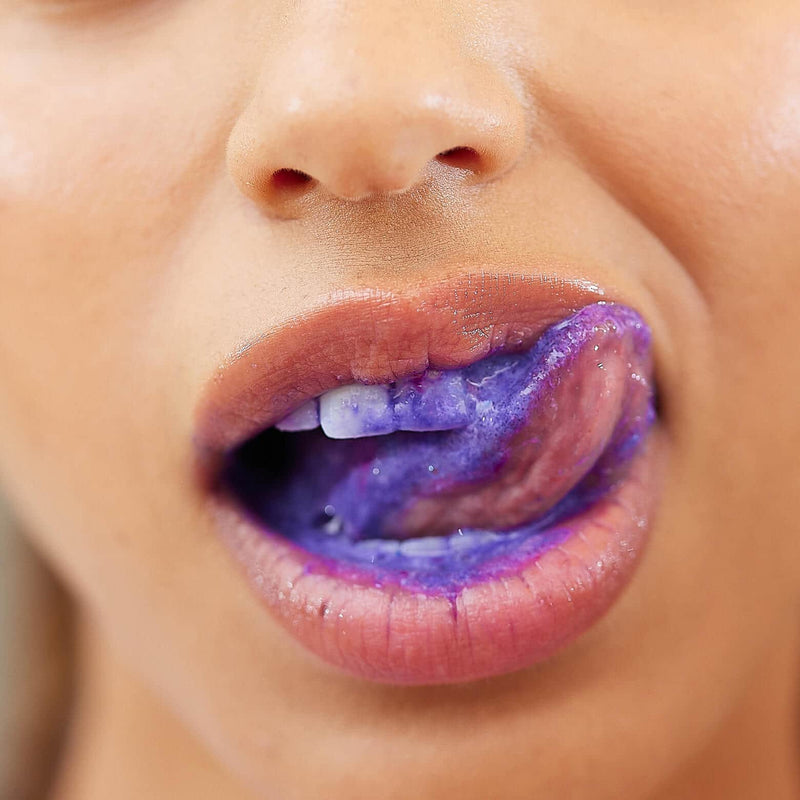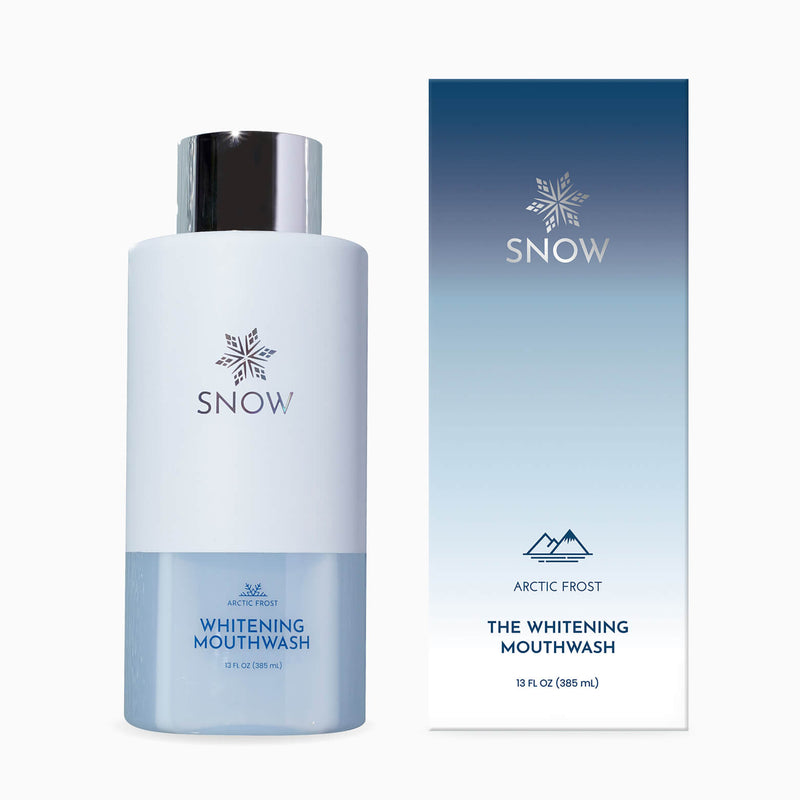Austin Powers might’ve been able to pull off yellow teeth, but most of us are not quite that lucky. We want positive attention for our smiles.
My personal quest for whiter teeth was thrust upon me from childhood as I became all too familiar with the lovely taste of baking soda. My dad made me brush with that stuff regularly. Those cleanings came with lots and lots of gagging and spitting.
I would coat my soft-bristled Reach toothbrush in that darn powder. And then, I’d hesitantly put that brush up to my lips as the powder fell off into the sink. Quickly, my vigorous brushing would ensue.

I was determined to scrub my little, yellow teeth into white perfection.
Even from a young age, I knew that having an attractive smile was seen as a big deal.
Our American culture truly loves a beautiful, white smile. We talk about it. We strive for it. A white smile doesn’t happen by accident. It takes care.
But what about a yellow smile? What causes a yellow smile?
Why do teeth turn yellow?
Do our teeth burst through the gums as babies in a lovely shade of yellow? Not usually, no. If those baby teeth appear slightly yellow, it’s because the enamel layer is thinner and the yellow dentin is showing through.
So in that case, the teeth were slightly yellow due to genetics.
But how do your healthy white teeth end up turning dingy yellow?

Thinning of the Enamel
The enamel on our teeth thins over time. It naturally wears down just because we eat! The unavoidable act of chewing wears down our enamel, causing it to thin.
Guess what lies beneath that thinning enamel? Dentin. Deep yellow, sometimes brown (!!) dentin, just waiting behind the enamel to make its debut. Dentin is the main culprit in the appearance of yellow teeth.
As enamel is thinned and worn away, Cyndi Lauper’s lyrics have never rung more true … “I see your true colors shining through …”
Aging Effects On Teeth
So many lovely things happen to our bodies as we age. We get more wrinkles, we injure ourselves by getting out of a chair, and our teeth turn yellow. Genes and family history play a role in the teeth yellowing with age, too.
And dentin plays a starring role in the ageing process. Dadgum dentin. It actually thickens as we age, so when combined with thinning enamel, that yellow shade shows right through.
Diet Effects On Teeth
Yep. If you’re overweight, your teeth are sure to be yellow. Just kidding. That’s not what we mean by diet in this case. We actually just mean certain foods stain your teeth.

Tannins have quite the staying power. They are notorious for stains. We typically associate tannins with wine, but that is not the only place they’re found. Here’s a list of tannin-rich food and drinks:
- Tea
- Coffee
- Balsamic vinegar
- Curry
- Tomato-based sauces
- Berries
- Beetroot
- Cola
- Soy sauce
- Fruit juice
Tannins have the unfortunate quality of stickiness. They stick to our teeth and cause the enamel to be discolored.
A good rule of thumb is that if it stains your clothes, it can stain your teeth.
Smoking Effects On Teeth
If you smoke regularly, your teeth will be discolored. The nicotine in cigarettes and chewing tobacco is highly addictive. The beautiful, black, scummy tar also wreaks havoc in the mouth.
Smoking is terrible for oral health. It can lead to gum disease, mouth cancers, and weak teeth. Staining and discoloration are the more obvious side effects of smoking.
If you want to have healthy, white teeth, then do not smoke. You are just re-staining your teeth over and over.
Medications Associated with Diseases
There are very few diseases that directly cause yellowing of the teeth. Cancer patients who experience head and neck chemotherapy and radiation end up with yellowed teeth because of the chemical reactions occurring within the body. (As if losing your hair and being depleted of your strength wasn’t enough, your teeth turn yellow!)
In addition, particular antibiotic medications like tetracycline and doxycycline can also stain teeth.
Unfortunately, some of the strongest mouth rinses are also slightly too strong for the enamel. Their ingredients of chlorhexidine and cetylpyridinium chloride are known to erode the enamel causing a yellow tinge.
Grinding The Teeth
Have you ever heard someone grinding their teeth in the middle of the night? It will wake you up from a dead sleep.
There are a lot of people who grind their teeth as a reaction to stress. Some people do it to relieve stress and it becomes a habit. Others do it in their sleep without even knowing it's happening!
This lovely little grinding habit is called bruxism. It damages the tooth enamel, which in turn weakens it and leads to yellow, brittle teeth.
Sugary and High-Carb Foods
Sugary foods, carbonated beverages, fizzy drinks, and high-carb foods are not friendly to our enamel. The same can be said for citrus or acidic fruits. They have a tendency to break down the enamel and foster the formation of tooth decay and staining. Hello, yellow.
What is Another Culprit of Yellowing Teeth?
Lifestyle. Yep. It’s typically not just one choice you’ve made. It’s several choices made over and over again. It isn’t drinking one cup of coffee now and then. It isn’t having a balsamic vinaigrette on your salad once a week. It isn’t even having a cigarette at a party.

Yellow teeth occur after consistent choices are made to smoke regularly or to chew tobacco regularly. Stains set in after drinking coffee or wine on a consistent basis.
Imagine if you smoke and drink coffee! Or, imagine if you drink coffee every morning and red wine every evening.
You have set your lifestyle up in such a way that you are basically begging for your teeth to turn yellow.
The #1 Reason for Yellow Teeth
The main reason our teeth are yellow is genes—unavoidable, part-of-your-dna, genes. Amelogenesis imperfecta and dentinogenesis imperfecta are two disorders we get from one of our parents.
These diseases are autosomal dominant. That means that it only takes the presence of a single copy of the mutated gene for the disease to show up in us.
Both of these diseases cause inappropriate development of teeth and can lead to discoloration.
Genetics are also responsible for the thickness of our tooth enamel, which means our dentin may or may not show through.
Childhood Illness
Some infections that occur during childhood cause such a high fever that it results in yellowing of the teeth. In babies, metabolic diseases can readily induce the high fevers that lead to an imbalance in the protein and calcium content of the enamel. It is that protein-calcium imbalance that is responsible for tooth discoloration.
Two more diseases that cause yellowing are neonatal hyperbilirubinemia and severe neonatal jaundice. Neonatal hyperbilirubinemia has been known to change the color of infant teeth. Infantile jaundice in more severe cases can lead to yellow teeth.
Injury
Injuries in young kiddos can cause what parents often refer to as a “dead” tooth. Injuries acquired while playing sports or taking a tumble can disrupt the formation of tooth enamel in children when their permanent teeth are still developing. That can produce teeth with a grayish appearance.
Like I said, “dead” tooth … or you can get creative and call it zombie tooth.Okay, so it’s not exactly yellow, but it’s still a discoloration of our teeth!
Clearly, there are several reasons why our teeth turn yellow. The reasons vary from heredity to diet, lack of hygiene to high fever during childhood.
If you want to do something about your yellow teeth, you can check out the whitening system available with Snow. It is simple, safe, effective, and affordable.
Who knows why Austin Powers’s teeth are so yellow? Probably because they aren’t real. It’s all part of his garish personality. I can safely say that he wouldn’t have made it through childhood in my house with those yellow chompers!
























